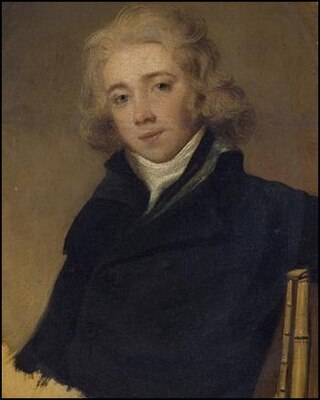Related Research Articles

Carl Ditters von Dittersdorf was an Austrian composer, violinist, and silvologist. He was a friend of both Haydn and Mozart. His best-known works include the German Singspiele Doktor und Apotheker and a number of programmatic symphonies based on Ovid's Metamorphoses.
This is a list of notable events in music that took place in the year 1735.
D major is a major scale based on D, consisting of the pitches D, E, F♯, G, A, B, and C♯. Its key signature has two sharps. The D major scale is:
F major is a major scale based on F, with the pitches F, G, A, B♭, C, D, and E. Its key signature has one flat. Its relative minor is D minor and its parallel minor is F minor.
B-flat major is a major scale based on B♭, with pitches B♭, C, D, E♭, F, G, and A. Its key signature has two flats. Its relative minor is G minor and its parallel minor is B-flat minor.
A-flat major is a major scale based on A♭, with the pitches A♭, B♭, C, D♭, E♭, F, and G. Its key signature has four flats.
D minor is a minor scale based on D, consisting of the pitches D, E, F, G, A, B♭, and C. Its key signature has one flat. Its relative major is F major and its parallel major is D major.
A minor is a minor scale based on A, with the pitches A, B, C, D, E, F, and G. Its key signature has no flats and no sharps. Its relative major is C major and its parallel major is A major.
C-sharp minor is a minor scale based on C♯, with the pitches C♯, D♯, E, F♯, G♯, A, and B. Its key signature consists of four sharps.
F minor is a minor scale based on F, consisting of the pitches F, G, A♭, B♭, C, D♭, and E♭. Its key signature consists of four flats. Its relative major is A-flat major and its parallel major is F major. Its enharmonic equivalent, E-sharp minor, has six sharps and the double sharp F, which makes it impractical to use.

Jean-Marie Leclair l'aîné was a French Baroque violinist and composer. He is considered to have founded the French violin school. His brothers, the lesser-known Jean-Marie Leclair the younger (1703–77) as well as Pierre Leclair (1709–84) and Jean-Benoît Leclair, were also musicians.

Hyacinthe Jadin was a French composer who came from a musical family. His uncle Georges Jadin was a composer in Versailles and Paris, along with his father Jean Jadin, who had played bassoon for the French Royal Orchestra. He was one of five musical brothers, the best known of whom was Louis-Emmanuel Jadin.

Frédéric Blasius was a French violinist, clarinetist, conductor, and composer. Born MatthäusBlasius, he used Frédéric as his pen name on his publications in Paris.
References
- Rita Benton: "Jean-Frédéric Edelmann, a Musical Victim of the French Revolution", Musical Quarterly, l (1964), 165–187
- Rita Benton: "The Instrumental Music of Jean-Frédéric Edelmann: a Thematic Catalogue and List of Early Editions", Fontes Artis Musicae, xi (1964), 79–88
- Sylvie Pécot-Douatte: A la recherche d'Edelmann le musicien guillotiné, l'Harmattan, Paris (2001)